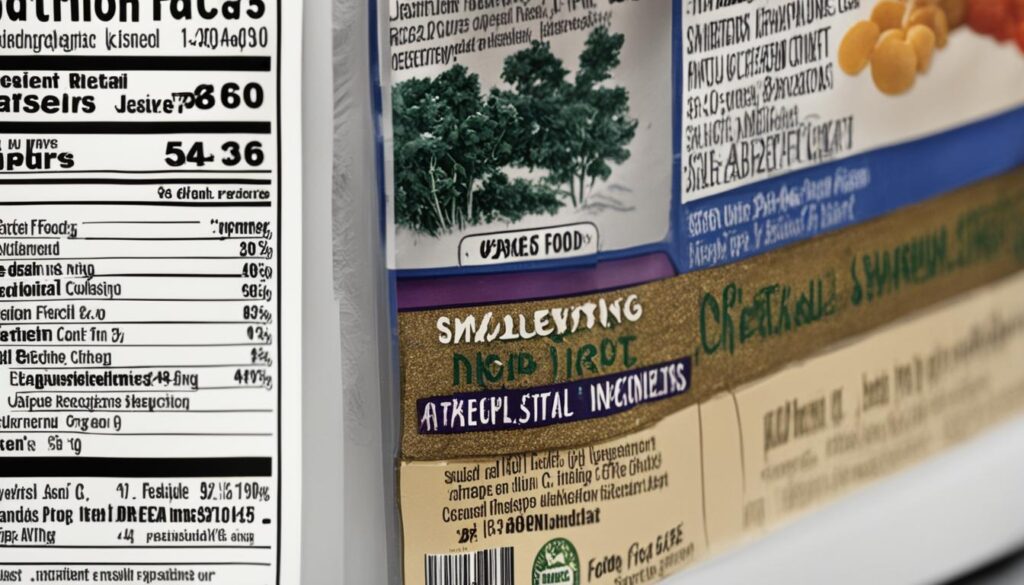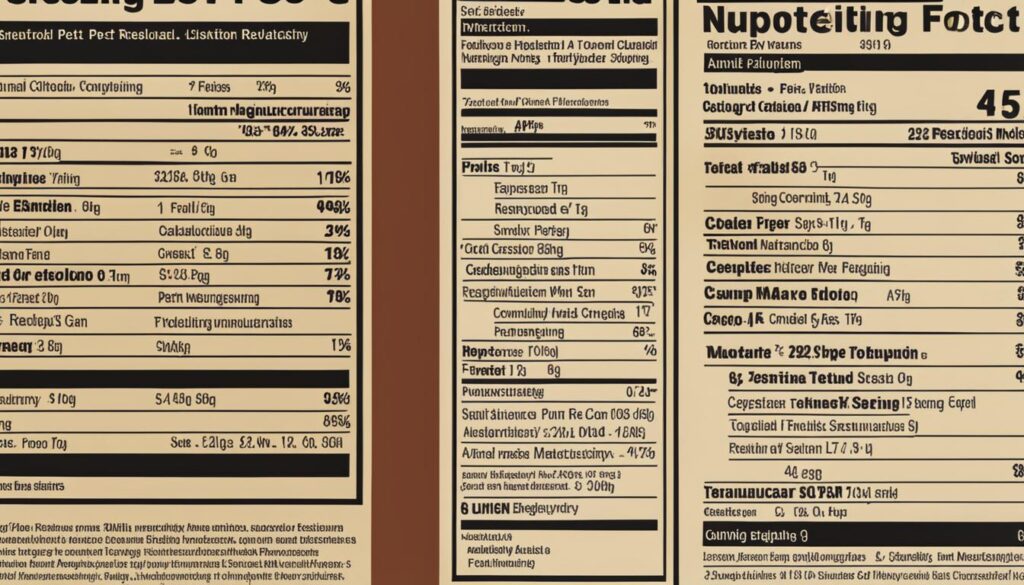As a responsible pet owner, you want to ensure that your furry friend is receiving the proper nutrition they need to thrive. But when it comes to deciphering dog food labels, it can feel like navigating a maze of confusing information. Don’t worry, we’re here to help you understand the ins and outs of dog food labels and make informed choices for your beloved pup.
Dog food nutrition labels may seem overwhelming at first glance, but they hold valuable information that can help you evaluate the quality of the food you’re purchasing. By learning how to read and decode these labels, you’ll be able to assess the nutritional value and make informed decisions about what’s best for your dog.
How to Read Dog Food Nutrition Labels
Reading dog food nutrition labels is essential in understanding the ingredients, nutrient content, and serving guidelines. We’ll walk you through the key elements to look out for, such as ingredient lists, guaranteed analysis, and feeding recommendations. You’ll gain the knowledge to determine which dog food is tailored to your pet’s needs.
Evaluating Dog Food Quality Through Labels
Not all dog foods are created equal, and labels can provide important clues about the quality of the product. We’ll share valuable tips on how to assess the overall quality of dog food, including understanding ingredient ratios, identifying desirable and undesirable ingredients, and considering the presence of superfoods. With this knowledge, you’ll be able to choose the best food for your furry companion.
Key Takeaways:
- Understanding dog food labels is crucial for pet owners to make informed decisions about their dog’s nutrition.
- Knowing how to read and decode dog food nutrition labels helps evaluate the quality of the food.
- Evaluating dog food quality involves assessing ingredient lists, nutrient content, and considering the presence of superfoods.
- Reading dog food serving sizes and understanding expiration dates are important for your dog’s health and safety.
- By decoding dog food labels, you can ensure your furry friend receives the best nutrition possible.
Understanding Dog Food Ingredients
When it comes to choosing the right dog food for your furry friend, understanding the ingredients listed on the label is crucial. By interpreting dog food ingredient lists, you can make informed decisions about the quality and suitability of the food for your beloved pet.
On the label, ingredients are usually listed in descending order by weight. This means that the first few ingredients listed are the most abundant in the food. Look for whole, recognizable ingredients like chicken, beef, or salmon. These high-quality protein sources are essential for your dog’s overall health and well-being.
It’s also important to pay attention to ingredient ratios. While some dog food brands may boast a specific ingredient as the main feature, it’s essential to consider the overall balance of the formula. A well-balanced dog food should contain a good combination of protein, carbohydrates, fats, and essential nutrients to support your dog’s specific dietary needs.

Deciphering Dog Food Protein Claims
When evaluating dog food nutrition facts, protein is one of the key factors to consider. Dog food labels often prominently display protein claims, but understanding what these claims actually mean can be a challenge. Let’s decode dog food protein claims and learn how to evaluate them to make informed choices for your furry friend’s diet.
Protein claims on dog food labels can vary, and it’s important to understand the difference between different types of protein sources. For example, a label might feature claims such as “real chicken,” “chicken meal,” or “chicken by-product meal.” The term “real chicken” indicates that the product contains whole chicken, while “chicken meal” refers to a concentrated form of chicken with the water removed. On the other hand, “chicken by-product meal” includes parts of the chicken that are not typically consumed by humans, such as organs and bones.
| Protein Claim | Description |
|---|---|
| Real Chicken | Contains whole chicken |
| Chicken Meal | Concentrated form of chicken with water removed |
| Chicken By-Product Meal | Includes organs and bones |
While “real chicken” may sound like the most desirable option, it’s important to note that the water content in whole chicken can significantly impact the protein content. Chicken meal, with its concentrated form, may actually provide a higher protein content. Evaluating the protein claims on dog food labels involves considering the quality and source of the protein, as well as the guaranteed analysis of the product.
When evaluating dog food nutrition facts, protein is one of the key factors to consider. Dog food labels often prominently display protein claims, but understanding what these claims actually mean can be a challenge. Let’s decode dog food protein claims and learn how to evaluate them to make informed choices for your furry friend’s diet.
Protein claims on dog food labels can vary, and it’s important to understand the difference between different types of protein sources. For example, a label might feature claims such as “real chicken,” “chicken meal,” or “chicken by-product meal.” The term “real chicken” indicates that the product contains whole chicken, while “chicken meal” refers to a concentrated form of chicken with the water removed. On the other hand, “chicken by-product meal” includes parts of the chicken that are not typically consumed by humans, such as organs and bones.
| Protein Claim | Description |
|---|---|
| Real Chicken | Contains whole chicken |
| Chicken Meal | Concentrated form of chicken with water removed |
| Chicken By-Product Meal | Includes organs and bones |
While “real chicken” may sound like the most desirable option, it’s important to note that the water content in whole chicken can significantly impact the protein content. Chicken meal, with its concentrated form, may actually provide a higher protein content. Evaluating the protein claims on dog food labels involves considering the quality and source of the protein, as well as the guaranteed analysis of the product.
Analyzing Dog Food Nutritional Information
When it comes to choosing the right dog food for your furry friend, understanding the nutritional information on the label is crucial. The nutritional facts provide valuable insights into the composition and quality of the food. Let’s take a closer look at how to interpret dog food nutrition facts and the labeling requirements that ensure accurate information for pet owners.
The Guaranteed Analysis:
The guaranteed analysis section of the dog food label outlines the minimum or maximum amounts of key nutrients in the product. This information gives you an overview of the protein, fat, fiber, and moisture content, among others. Pay attention to the order in which these nutrients are listed, as it indicates their relative amounts. For example, if protein is listed first, you can expect a higher protein content in the food.
Nutritional Requirements:
The Association of American Feed Control Officials (AAFCO) sets the nutritional requirements for dog food labeling in the United States. Dog food manufacturers must meet these standards to provide adequate nutrition for dogs at different life stages. Look for the AAFCO statement on the label, which indicates whether the food is suitable for growth, adult maintenance, or all life stages. This ensures that the food meets the necessary nutrient levels to support your dog’s health.
Challenges in Comparing Nutritional Information:
It’s important to note that comparing dog food based solely on nutritional information can be challenging. Every dog is unique with different dietary needs, and factors such as activity level, age, and overall health should also be considered. Additionally, the quality and digestibility of ingredients play a significant role in the nutritional value of the food. Consulting with a veterinarian can help you make an informed decision about the best diet for your dog.
Table: Dog Food Nutritional Information Breakdown
| Nutrient | Description |
|---|---|
| Protein | The building block for strong muscles and essential for overall growth and maintenance. |
| Fat | A concentrated source of energy and necessary for healthy skin and coat. |
| Fiber | Aids in digestion and promotes bowel regularity. |
| Moisture | The amount of water in the food, which affects the overall texture and palatability. |
| Calcium | Essential for strong bones and teeth. |
| Phosphorus | Works with calcium to maintain bone health and proper cell function. |
Remember, dog food nutrition facts provide valuable information, but they should be considered alongside other factors to determine the best food for your dog. By understanding the guaranteed analysis, nutritional requirements, and the challenges of comparing food, you can make informed decisions that support your furry friend’s health and well-being.
Decoding Dog Food Serving Sizes and Expiry Dates
When it comes to providing the best nutrition for your furry friend, understanding dog food serving sizes and expiry dates is just as important as deciphering the labels. Let’s take a closer look at how to navigate these crucial aspects of dog food packaging.
Determining the Right Serving Size
One of the first things you’ll notice on a dog food label is the recommended serving size. While it may seem straightforward, determining the right amount of food to feed your dog can be a bit tricky. Serving sizes on dog food labels are typically based on the weight and activity level of an average adult dog. However, every dog is unique, so it’s essential to consider factors such as breed, age, metabolism, and overall health when determining the appropriate serving size for your furry friend. Consulting with your veterinarian can also provide valuable insights into the specific dietary needs of your dog.
Remember, serving sizes are just a starting point. It’s essential to monitor your dog’s weight and adjust the amount of food accordingly. Observe your dog’s body condition and energy level to ensure they are getting the right amount of food to maintain a healthy weight and overall well-being.
Checking Expiry Dates for Freshness and Safety
Another critical aspect to consider when purchasing dog food is checking the expiry dates. All dog food products must have a clearly marked expiry date to ensure freshness and safety. Expired dog food can not only lose nutritional value but may also pose health risks to your pet. When shopping for dog food, always check the expiration date to make sure the product is within its recommended shelf life.
It’s also worth noting that proper storage of dog food plays a role in maintaining its freshness. Be sure to store the food in a cool, dry place and seal it tightly after each use to preserve its quality. If you notice any unusual odors, mold, or other signs of spoilage, it’s best to discard the food to ensure your dog’s health and safety.
Table: Understanding Dog Food Serving Sizes and Expiry Dates
| Key Points | Details |
|---|---|
| Recommended serving size | Based on weight, activity level, and other factors |
| Adjusting serving sizes | Monitor body condition and energy level, consult with a veterinarian |
| Checking expiry dates | Ensure freshness and safety, discard expired products |
| Proper storage | Cool, dry place, tightly sealed containers |
| Signs of spoilage | Unusual odors, mold, or other noticeable changes |
By understanding dog food serving sizes and expiry dates, you can ensure that your beloved pet receives the appropriate amount of nutrition and enjoys fresh, safe meals. Remember, always consult with your veterinarian for personalized dietary recommendations based on your dog’s specific needs.

Superfoods have become a buzzword in the world of human nutrition, and now they are making their way into our furry friends’ diets as well. But what exactly are superfoods, and what role do they play in dog food? Superfoods are nutrient-dense ingredients that provide a range of health benefits. They are packed with vitamins, minerals, and antioxidants, which can support your dog’s overall health and well-being.
Some commonly used superfoods in dog food include blueberries, sweet potatoes, kale, and chia seeds. Blueberries, for example, are rich in antioxidants that help protect your dog’s cells from damage caused by free radicals. Sweet potatoes are a great source of complex carbohydrates and fiber, providing sustained energy and supporting digestive health. Kale is packed with vitamins A, C, and K, as well as calcium and potassium, which are essential for healthy bones and muscles. Chia seeds are a good source of omega-3 fatty acids, which can help reduce inflammation and support a healthy coat and skin.
When choosing dog food with superfoods, it’s important to read the ingredient list and ensure that the superfood is listed high up. This indicates that there is a significant amount included in the recipe. However, it’s also essential to remember that superfoods should not replace a balanced diet. They should be used as part of a well-rounded and nutritious meal plan for your dog. If your dog has any specific dietary needs or sensitivities, it’s always best to consult with your veterinarian before introducing new ingredients into their diet.
Navigating Allergen Information on Dog Food Labels
Allergies and sensitivities are common in dogs, and it’s crucial to be aware of any potential allergens in their food. Dog food labels often include allergen information to help pet owners make informed choices. If your dog has known allergies or sensitivities, it’s essential to carefully read the ingredient list and look for any potential triggers. Common allergens in dog food include grains like wheat, corn, and soy, as well as certain proteins like beef, chicken, and dairy products.
Some dog food labels may also include statements such as “grain-free” or “gluten-free” to indicate that the product doesn’t contain certain allergens. However, it’s essential to note that these claims do not guarantee that the food will be suitable for all dogs with allergies or sensitivities. Every dog is unique, and what works for one may not work for another.
If you suspect that your dog has a food allergy or sensitivity, it’s best to consult with your veterinarian. They can help you identify the potential allergens and recommend a suitable diet for your furry friend. Remember, always read the labels, understand the ingredients, and prioritize your dog’s unique needs when choosing their food.
| Superfood | Benefits |
|---|---|
| Blueberries | Rich in antioxidants that protect cells from damage |
| Sweet Potatoes | Provides sustained energy and supports digestive health |
| Kale | Packed with vitamins and minerals for healthy bones and muscles |
| Chia Seeds | Good source of omega-3 fatty acids for a healthy coat and skin |
“Superfoods are like a nutritional powerhouse for your dog. They provide a wide range of beneficial nutrients that can support their overall health and well-being.” – Dr. Emily Thompson, DVM
Understanding Dog Food Label Regulations
When it comes to understanding dog food labels, it’s essential to familiarize yourself with the regulations that govern them. In the United States and Canada, dog food labeling requirements are enforced by organizations such as the Association of American Feed Control Officials (AAFCO) and the Food and Drug Administration (FDA). These regulations aim to ensure that pet food manufacturers provide accurate and transparent information about their products.
One important aspect of dog food label regulations is the requirement for nutritional adequacy statements. These statements indicate whether a particular dog food is formulated to meet the minimum nutritional requirements for a specific life stage, such as growth, adult maintenance, or all life stages. This information can help pet owners choose a dog food that is appropriate for their pet’s specific needs.
Another area of focus in dog food label regulations is the explanation of dog food label claims. Labels often feature claims such as “all-natural,” “grain-free,” or “high-protein.” However, it’s important to understand that these claims may not always have a standardized definition. In some cases, they may be regulated by AAFCO, while in others, they may not. It’s crucial to read the fine print and do your research to ensure that the claims on the dog food label align with your pet’s dietary requirements.
To summarize, understanding dog food label regulations is key to making informed decisions about the food you provide for your furry friend. By familiarizing yourself with the organizations involved in regulating pet food, knowing the requirements for nutritional adequacy statements, and interpreting dog food label claims, you can ensure that you are choosing a high-quality diet that meets your pet’s needs.

Table: Key Dog Food Label Regulations
| Regulating Organization | Country | Key Responsibilities |
|---|---|---|
| Association of American Feed Control Officials (AAFCO) | United States and Canada | Develop and enforce standards for pet food labeling, including nutritional adequacy statements |
| Food and Drug Administration (FDA) | United States | Regulate and monitor the safety and labeling of pet food products |
Conclusion
Now that you have a comprehensive understanding of dog food labels, you can confidently evaluate the quality of the food you provide for your furry friend. By decoding the information on dog food labels, you can make informed decisions about the ingredients, nutrient content, and serving sizes.
Evaluating dog food quality through labels is crucial for ensuring your dog receives the best nutrition possible. Take the time to read and interpret the ingredient lists, paying attention to desirable and undesirable ingredients. Look for the nutritional information provided in the guaranteed analysis and compare it to your dog’s specific dietary needs.
Remember to consider the serving sizes recommended on dog food labels, as these can vary based on your dog’s age, size, and activity level. And don’t forget to check the expiry dates to ensure the food is fresh and safe for consumption. Taking these steps will help you provide your furry friend with the nourishment they deserve.
FAQ
How do I understand and read dog food nutrition labels?
Understanding dog food nutrition labels involves decoding the information provided on the label, evaluating ingredient lists, nutrient content, and serving sizes to make informed choices about your dog’s food.
What should I look for in dog food ingredient lists?
When evaluating dog food ingredient lists, it’s important to look for high-quality, recognizable ingredients. Avoid excessive fillers, by-products, and artificial additives, and focus on real meat and whole grains.
What are dog food protein claims, and how do I evaluate them?
Dog food protein claims refer to the protein content in the food. Understanding these claims involves differentiating between “whole” meat and meat meal and being aware of misleading practices. Evaluating protein content is crucial for a balanced diet.
What nutritional information should I focus on in dog food labels?
Pay attention to the guaranteed analysis, which provides important information on the nutrient content of the dog food. Look for essential nutrients, such as proteins, fats, carbohydrates, vitamins, and minerals, in appropriate ratios.
How do I determine the appropriate serving size for my dog?
Interpreting serving sizes on dog food labels requires considering factors like your dog’s size, age, activity level, and metabolism. Consulting with your veterinarian is advisable for personalized recommendations.
What are superfoods in dog food, and why are they important?
Superfoods in dog food are nutrient-dense ingredients that provide additional health benefits. They offer a range of vitamins, antioxidants, and essential fatty acids. Allergen information on dog food labels is also important for pet owners to be aware of.
How are dog food labels regulated?
Dog food labels are regulated by organizations like AAFCO and FDA in the United States and Canada. These organizations have specific requirements for dog food labeling, including nutritional adequacy statements and accurate ingredient listing.
How do I evaluate the quality of dog food through labels?
By decoding the information provided on dog food labels, evaluating ingredient lists, nutrient content, serving sizes, and understanding dog food label regulations, you can make informed choices and ensure your dog receives the best nutrition possible.





